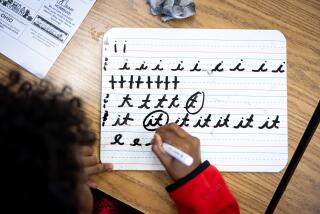Don’t write off penmanship just yet
- Share via
Thank goodness for technology. With e-mail delivering us from the need for the handwritten note, so too does it deliver all future generations from the drudgery of penmanship instruction. Phew!
Actually, penmanship lessons continue in elementary schools. But why continue this antiquated discipline at all?
Object all you want; penmanship’s proponents aren’t letting go. Indeed, they say, we take our penmanship for granted at the peril of our self-identities and even society as a whole.
Oregon’s Barbara Getty, who writes handwriting instruction books, says care in penmanship is not just sentimental clinging to a dying art but a matter of practical necessity. She notes that post offices in larger cities often need full-time workers who specialize in the art of deciphering sloppily written addresses.
If our collective handwriting has gone downhill, Peggy Jones has nothing to do with it. Jones, who teaches at Calvin Leete Elementary School in Guilford, Conn., says penmanship instruction has remained pretty much the same in her classroom as when she started teaching 34 years ago.
She doesn’t go along with the view that longhand is obsolete. Even if no one picked up a pen and pad again, there always would be historically important letters, like those written by Civil War soldiers, or the Declaration of Independence. If you can’t write cursive, she says, you probably can’t read it.
But some educators say penmanship instruction doesn’t go far enough and blame the notion that computers can take the place of pen and pad. The people at Zaner-Bloser, an Ohio publisher of handwriting textbooks, note that most classrooms have only a few computers at most. And even the most technologically plugged-in still write Post-it notes and to-do lists in longhand, says Richard Northup, vice president of Zaner-Bloser.
Kathy Feig, a professional calligrapher in Canada, has long advocated more intensive penmanship lessons in elementary schools. Handwriting is a form of self-expression, and when we can’t read our own writing, she says, we have a certain disconnect from ourselves. She admits there are no specific data to support her theory, but Feig believes better penmanship means a better understanding of ourselves and consequently a calmer, more stable society. “When our writing is clearer, our thinking is clearer,” she says.
And then there’s money. Some studies show that millions of dollars are lost thanks to illegible scribbles and letters whose addresses are so ineptly marked that even postal workers can’t decipher them.
Some penmanship advocates believe writing by hand is a natural instinct that keyboards can’t replace. The scrawls in animal blood that lined caves and toddlers who take to the walls with whatever tool they can get their hands on serve as evidence. “It just seems we’ve always wanted to express ourselves, from the cavemen on,” Getty says.
She points out that bad penmanship can be a matter of life and death. A few years ago, the Institute of Medicine estimated that 7,000 people die every year as the result of medication errors. Poor handwriting was one of the listed causes.
It’s a myth that doctors have particularly bad penmanship, Getty says, but their writing makes “the ultimate impact.” Up to 92% of prescriptions are written by hand.
And though life doesn’t hang in the balance of most people’s penmanship, she says, a nicely written note goes a long way to brightening someone’s day. A poorly written one, though, comes off as “mumbling on paper” and even a little disdainful. “So do I think we still need handwriting?” Getty asks. “I say yes!”






